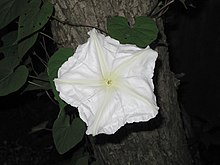
Back أثمان أبيض Arabic اثمان ابيض ARZ Ipomoea alba Azerbaijani Ipomoea alba CEB Ipomoea alba German Blanka ipomeo Esperanto Ipomoea alba Spanish نیلوفر سفید Persian Ipomoea alba French Běła wijawka HSB
| Ipomoea alba | |
|---|---|

| |
| Scientific classification | |
| Kingdom: | Plantae |
| Clade: | Tracheophytes |
| Clade: | Angiosperms |
| Clade: | Eudicots |
| Clade: | Asterids |
| Order: | Solanales |
| Family: | Convolvulaceae |
| Genus: | Ipomoea |
| Species: | I. alba
|
| Binomial name | |
| Ipomoea alba | |
Ipomoea alba, known in English as tropical white morning glory, moonflower or moonvine, is a species of night-blooming morning glory, native to tropical and subtropical regions of North and South America, from Argentina to northern Mexico, Arizona, Florida[3] and the West Indies.[4] Though formerly classified as genus Calonyction, species aculeatum, it is now properly assigned to genus Ipomoea, subgenus Quamoclit, section Calonyction.[5]
- ^ Canteiro, C. (2021). "Ipomoea alba". IUCN Red List of Threatened Species. 2021: e.T126421388A158506713. doi:10.2305/IUCN.UK.2021-1.RLTS.T126421388A158506713.en. Retrieved 18 November 2021.
- ^ NatureServe (2024). "Ipomoea alba". Arlington, Virginia. Retrieved 15 February 2024.
- ^ And Bly USDA, NRCS (n.d.). "Ipomoea alba". The PLANTS Database (plants.usda.gov). Greensboro, North Carolina: National Plant Data Team. Retrieved 20 May 2015.
- ^ Liogier, A.H.; Liogier, H.A.; Martorell, L.F. (2000). Flora of Puerto Rico and Adjacent Islands: A Systematic Synopsis. Ed. de la Universidad. p. 163. ISBN 978-0-8477-0369-2. Archived from the original on 28 July 2022. Retrieved 7 January 2020.
- ^ "Ipomoea alba". Germplasm Resources Information Network. Agricultural Research Service, United States Department of Agriculture. Retrieved 17 December 2017.

